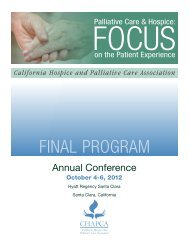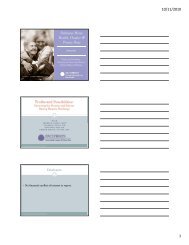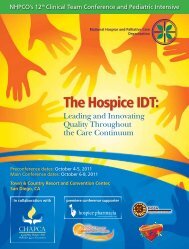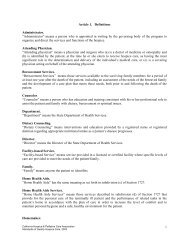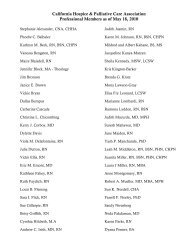Hospice Inpatient Care - California State Hospice Association
Hospice Inpatient Care - California State Hospice Association
Hospice Inpatient Care - California State Hospice Association
Create successful ePaper yourself
Turn your PDF publications into a flip-book with our unique Google optimized e-Paper software.
9/23/2010<br />
2010 CHAPCA Annual<br />
Conference<br />
Session 3C: <strong>Hospice</strong> <strong>Inpatient</strong> <strong>Care</strong> –<br />
Options in Today’s Market<br />
Presenters<br />
Facilitators:<br />
• Holly Swiger, RN, MPH, PhD & VP<br />
VITAS Healthcare Corporation<br />
• Brenda Klütz, Senior Consultant<br />
Health Management Associates<br />
Panelists:<br />
• Vanessa Bengston, RN, CPHQ & Executive Director<br />
<strong>Hospice</strong> of the Foothills (Grass Valley)<br />
• Audrey Flower, Executive Director<br />
Madrone <strong>Hospice</strong> (Yreka)<br />
• Sharon O’Mary, Executive Director of Patient <strong>Care</strong> Services<br />
San Diego <strong>Hospice</strong><br />
Session Goals:<br />
• Learn how inpatient care fits into the<br />
continuum of hospice care<br />
• Learn of federal certification and state<br />
licensing options for providing inpatient care<br />
• Learn of creative options and alternatives for<br />
providing inpatient care<br />
• Learn from the experience of other hospice<br />
providers who operate hospice homes and<br />
provide both residential and inpatient care<br />
• Questions and Comments<br />
1
9/23/2010<br />
Portability of <strong>Hospice</strong> <strong>Care</strong><br />
• The portability of hospice services is a<br />
strength, but it can also become<br />
complicated<br />
• The type of care that is provided<br />
• The place in which the care can be<br />
provided<br />
Types of <strong>Hospice</strong> Services<br />
• Routine <strong>Care</strong><br />
• Continuous <strong>Care</strong><br />
• Short-term General <strong>Inpatient</strong> (symptom<br />
management & pain control)<br />
• <strong>Inpatient</strong> Respite <strong>Care</strong><br />
Where <strong>Hospice</strong> Services can be<br />
Provided: Routine <strong>Care</strong><br />
• Home<br />
• Residential <strong>Care</strong><br />
• Health Facility<br />
2
9/23/2010<br />
Where <strong>Hospice</strong> Services can be<br />
Provided: Continuous <strong>Care</strong><br />
• Home<br />
• Residential Facility<br />
• Health Facility (excluding a hospital)<br />
Where <strong>Hospice</strong> Services can be<br />
Provided: Short-term <strong>Inpatient</strong><br />
• 42 CFR § 418.108 – COP: Short-term<br />
inpatient care.<br />
• Must be provided in a Medicare or<br />
Medicaid facility<br />
Where <strong>Hospice</strong> Services can be<br />
Provided: Short-term <strong>Inpatient</strong><br />
<strong>Inpatient</strong> care for symptom management and pain control –<br />
must be provided in one of the following:<br />
• A Medicare-certified hospice that meets the CoP for<br />
providing inpatient care directly (§418.110)<br />
r<br />
• A Medicare-certified hospital or skilled nursing facility<br />
that also meets §418.110(b) & (e) regarding 24-hour<br />
nursing services and patient areas<br />
3
9/23/2010<br />
Where <strong>Hospice</strong> Services can be<br />
Provided: Short-term <strong>Inpatient</strong><br />
<strong>Inpatient</strong> care for respite must be provided in one of the following:<br />
• A Medicare-certified hospice that meets the CoP for providing<br />
inpatient care directly (§418.110)<br />
• A Medicare-certified hospital or skilled nursing facility that also<br />
meets §418.110(b) 110(b) & (e) regarding 24-hour nursing services and<br />
patient areas<br />
• A Medicare or Medicaid-certified nursing facility that also meets<br />
§418.110(e)<br />
Federal Certification Requirements:<br />
Condition of Participation (COP)<br />
• 42 CFR § 418.110: COP: <strong>Hospice</strong>s that<br />
provide inpatient care directly.<br />
• In its own facility<br />
<strong>State</strong> Licensing Options for Providing<br />
<strong>Inpatient</strong> <strong>Care</strong><br />
• Hospital<br />
• Skilled Nursing Facility<br />
• Intermediate <strong>Care</strong> Facility<br />
• Congregate Living Health Facility<br />
4
9/23/2010<br />
Challenges to Providing <strong>Inpatient</strong><br />
<strong>Care</strong> Directly<br />
<strong>Hospice</strong> providers must ensure that their<br />
facility meet state requirements:<br />
• Health facility licensing requirements<br />
• Building standards<br />
• Retail Food Act standards (unless food is<br />
being prepared offsite)<br />
Challenges to Providing <strong>Inpatient</strong><br />
<strong>Care</strong> Directly<br />
<strong>Hospice</strong> providers must ensure that their facility<br />
meet certification requirements:<br />
• For category of facility (hospital, SNF, ICF,<br />
CLHF)<br />
• For hospice CoPs such as Life Safety Code<br />
and other standards under §418.110<br />
Challenges to Providing <strong>Inpatient</strong><br />
<strong>Care</strong> Directly<br />
<strong>Hospice</strong> providers may also choose to be<br />
accredited by an accrediting organization<br />
5
9/23/2010<br />
Challenges to Providing <strong>Inpatient</strong><br />
<strong>Care</strong> Directly<br />
<strong>State</strong> Oversight requires that the facility be<br />
surveyed for:<br />
• Compliance with state licensing<br />
requirements<br />
• Compliance with federal certification<br />
requirements, including a life safety code<br />
survey<br />
<strong>Inpatient</strong> <strong>Care</strong> in a Hospital<br />
• In a hospital with services provided by the<br />
hospital, under arrangement/contract with a<br />
hospice<br />
• In a hospital with services provided directly by<br />
the hospice, under arrangement/contract<br />
• A hospice provider can provide inpatient care<br />
directly by being licensed as a hospital<br />
• One such hospital in <strong>California</strong><br />
<strong>Inpatient</strong> <strong>Care</strong> in a SNF<br />
• In a SNF with services provided by the SNF,<br />
under arrangement/contract with a hospice<br />
• In a SNF with services provided by a hospice,<br />
under arrangement/contract<br />
• A hospice provider can provide inpatient care<br />
directly by being licensed as a SNF<br />
• One such SNF in <strong>California</strong> that has been<br />
formally identified<br />
6
9/23/2010<br />
<strong>Inpatient</strong> <strong>Care</strong> in an ICF<br />
• In an ICF with services (except GIP) provided by the ICF,<br />
under arrangement/contract with a hospice<br />
• In a ICF with services provided directly by a hospice,<br />
under arrangement/contract<br />
• A hospice provider can provide inpatient care directly by<br />
being licensed as an ICF<br />
No ICF has been formally identified as providing inpatient care<br />
directly in CA<br />
<strong>Inpatient</strong> <strong>Care</strong> in a CLHF<br />
• A hospice provider can provide inpatient care<br />
directly by being licensed as an congregate<br />
living health facility (CLHF)<br />
• While there are 13 CLHFs licensed to hospice<br />
providers, not all provide inpatient level of<br />
care<br />
Providing GIP “inside” another<br />
health facility<br />
Federal CoPs clearly acknowledge that a<br />
hospice can lease space from a<br />
healthcare facility and operate their own<br />
hospice facility<br />
7
9/23/2010<br />
Providing GIP “inside” another<br />
health facility<br />
• If a health facility allows the hospice to use<br />
space under an Outside Resources Contract,<br />
those beds remain licensed to the host facility<br />
• The hospice must meet all of the licensing<br />
requirements for the host facility as well as<br />
those for the hospice<br />
Providing GIP “inside” another<br />
health facility<br />
A hospice cannot have an Outside<br />
Resources Contract for a portion of the<br />
beds in a CLHF<br />
CLHFs must be free-standing by state law<br />
<strong>Inpatient</strong> <strong>Care</strong> in Residential <strong>Care</strong><br />
Facilities?<br />
• The federal CoPs state that a hospice must provide<br />
inpatient care directly in its own facility.<br />
• The CoPs do not specify that the facility needs to be a<br />
health facility<br />
• There have been no residential facilities that have been<br />
formally identified as providing inpatient care directly.<br />
Stay Tuned!<br />
8
9/23/2010<br />
Questions or Comments?<br />
9
Contracting for <strong>Inpatient</strong> <strong>Care</strong><br />
Holly Swiger, RN, MPH, PhD<br />
VP of Public Affairs<br />
VITAS Healthcare Corporation<br />
CHAPCA Regulatory Committee Chair<br />
Holly.Swiger@VITAS.com<br />
1<br />
What Level of <strong>Hospice</strong> <strong>Care</strong> Can Be Provided<br />
in What <strong>Inpatient</strong> Setting?<br />
License Type GIP Respite Continuous<br />
<strong>Care</strong><br />
Routine<br />
Hospital C/O C/O No C/O<br />
Special Hospital: <strong>Hospice</strong> C/O C/O No C/O<br />
Skilled Nursing Facility (SNF) C/O C/O C/O C/O<br />
Intermediate <strong>Care</strong> Facility (ICF) O C/O C/O C/O<br />
Congregate Living Health Facility<br />
(CLHF)<br />
Residential <strong>Care</strong> Facility for the<br />
Chronically Ill (RCFCI)<br />
O O C/O C/O<br />
No No C/O C/O<br />
Residential <strong>Care</strong> Facility for the<br />
Elderly (RCFE)<br />
No No C C<br />
Adult Residential Facility (ARF) No No C C<br />
C = Contracted O = Operated<br />
If IPU is operated by the <strong>Hospice</strong>, it can do GIP or CC, but not both.<br />
2<br />
Who needs a contract?<br />
• Anytime your hospice enters a relationship<br />
where there is a need to clarify the<br />
expectations of the relationship.<br />
• This is done with either a contract or written<br />
agreement:<br />
– Patient Election<br />
– Hospital/SNF Contract for GIP/Respite<br />
– Nursing Home contract for routine care<br />
– Assisted living facilities for routine care<br />
– <strong>Hospice</strong> unit in a host facility<br />
3<br />
1
Types of Contracts for <strong>Inpatient</strong> Beds<br />
4<br />
Scatter Beds<br />
• <strong>Hospice</strong> contracts with a facility to provide<br />
care in whatever beds are available and<br />
where the host facility chooses to place the<br />
patient.<br />
– General <strong>Inpatient</strong> <strong>Care</strong> scatter beds<br />
• The hospital, skilled nursing facility or hospice (licensed<br />
as either of these or as a congregate living health<br />
facility)<br />
– Respite scatter beds<br />
• The hospital, nursing facility, intermediate care facility or<br />
hospice (licensed as one of the above or a congregate<br />
living health facility)<br />
5<br />
Scatter Beds<br />
• Easiest to contract.<br />
• Most difficult to keep host facility staff<br />
educated.<br />
• Difficult to obtain, in under bedded areas.<br />
• <strong>Hospice</strong> GIP & Respite reimbursement is<br />
far below hospital reimbursement.<br />
• <strong>Hospice</strong> Respite reimbursement is below<br />
SNF Medicaid reimbursement in some<br />
areas.<br />
6<br />
2
Scatter Beds<br />
• For GIP, the Host facility must provide<br />
RN 24/7 and levels of staffing equivalent<br />
to meet the needs of patients in crisis.<br />
• This level of care and intervention must<br />
be clearly l documented.<br />
d<br />
• <strong>Hospice</strong> staff must visit every day to<br />
assure management of care and<br />
documentation.<br />
7<br />
Dedicated <strong>Hospice</strong> Beds Under Contract<br />
• Contracted General <strong>Inpatient</strong> <strong>Care</strong> or Respite<br />
dedicated beds in a host facility.<br />
• Could be a couple of rooms or a wing.<br />
• <strong>Hospice</strong> guarantees payment per day (holds<br />
the bed for only hospice patients).<br />
• <strong>Hospice</strong> pays for ancillary services based on<br />
days of care (dietary, linen, housekeeping,<br />
etc.).<br />
• Contracted with the same facilities as float<br />
beds.<br />
8<br />
Dedicated <strong>Hospice</strong> Beds Under Contract<br />
• <strong>Hospice</strong> can create a more home like<br />
environment.<br />
• Dedicated host facility staff creates greater<br />
ease of training.<br />
• Dedicated and educated staff may require less<br />
oversight.<br />
• Better overall experience for patient/family.<br />
• Guaranteed income for the Host facilities.<br />
• If beds are not utilized, it is costly for the<br />
hospice.<br />
9<br />
3
<strong>Hospice</strong> Operated Unit in a Host Facility<br />
• <strong>Hospice</strong> operates a unit in a host facility<br />
under an Outside Resources Contract.<br />
• The beds remain licensed to the host facility.<br />
• <strong>Hospice</strong> gets it added to its program license<br />
(COP §418.108 and 418.110)<br />
• <strong>Hospice</strong> operates the unit.<br />
• <strong>Hospice</strong> may contract for staffing from the<br />
host facility.<br />
10<br />
<strong>Hospice</strong> Operated Unit in a Host Facility<br />
• No bricks and mortar investment.<br />
• Decorate it to suit patient/family needs.<br />
• Staff are hospice trained.<br />
• May contract with facility for staffing.<br />
• Less need for daily hospice visits.<br />
• Must keep unit occupied to break even.<br />
11<br />
<strong>Hospice</strong> Operated Unit in a Host Facility<br />
• Steady income for host facility.<br />
• Potential referrals from host facility.<br />
• Must keep unit occupied to break even.<br />
• Survey risk and potential fines for the<br />
host facility.<br />
• More difficult to find a host facility<br />
willing to enter this contractual<br />
arrangement in CA.<br />
12<br />
4
<strong>Hospice</strong> Operated Units/Facilities<br />
• San Diego <strong>Hospice</strong> – Sharon O’Mary<br />
– Special Hospital: <strong>Hospice</strong><br />
– Contracted <strong>Hospice</strong> Unit in a SNF<br />
• Madrone <strong>Hospice</strong> – Audrey Flower<br />
– CLHF (Residential <strong>Care</strong>)<br />
• <strong>Hospice</strong> of the Foothills – Vanessa Bengston<br />
– Congregate Living Health Facility<br />
13<br />
Questions?<br />
14 Selected Statistics 4-2010<br />
5
Sharon O’Mary<br />
(619) 278-6286<br />
somary@sdhospice.org<br />
<strong>Inpatient</strong> Unit Comparison<br />
ICC and GlenBrook <strong>Care</strong> Centers<br />
SDHIPM has two inpatient care centers, staffed entirely by its own employees. SDHIPM MDs and<br />
NPs provide daily visits. Skilled pain and symptom management is provided on either unit with<br />
access to infusions, medications, and other therapies.<br />
License/Beds<br />
Levels of <strong>Care</strong><br />
Staffing Matrix<br />
Challenges<br />
Positive<br />
Outcomes<br />
Pharmacy<br />
<strong>Inpatient</strong> <strong>Care</strong> Center<br />
4311 Third Avenue<br />
San Diego, CA 92103<br />
Special Acute <strong>Care</strong> Hospital<br />
24 beds<br />
Primary teaching site for Institute for<br />
Palliative Medicine<br />
General <strong>Inpatient</strong> – <strong>Hospice</strong><br />
DRG Admission – Palliative <strong>Care</strong><br />
Adheres to RN staffing ratios required<br />
for acute care hospital.<br />
75 staff<br />
Manager + Charge RN (patient free)<br />
Unit Medical Director + 2 Attending<br />
physicians + NP<br />
RN 1:4<br />
CNA 1:6<br />
MSW 1:12<br />
SPC 0.8:12<br />
Unit clerk 1:12<br />
Licensing – Permanent Pilot Acute<br />
Hospital and ongoing adherence to<br />
regulatory requirements<br />
Organized Medical Staff<br />
Cost<br />
Internal competition for limited beds<br />
Quality.<br />
Total control of palliative setting,<br />
treatment protocols & integrative<br />
therapies, operations, staffing,<br />
expenses.<br />
Certified palliative physicians.<br />
Academic setting for all disciplines.<br />
Physical identity for hospice in San<br />
Diego. .<br />
On Site. Pharmacist consultation on<br />
daily rounds.<br />
GlenBrook <strong>Care</strong> Center<br />
1950 Calle Barcelona<br />
Carlsbad, CA 92009<br />
Skilled Nursing Facility<br />
12 beds, leased<br />
General <strong>Inpatient</strong> - <strong>Hospice</strong>,<br />
Respite - <strong>Hospice</strong>.<br />
2 licensed nurses all shifts,<br />
regardless of census<br />
Charge Nurse (patient assignment)<br />
24 staff<br />
Attending physician + NP<br />
RN 1:6<br />
CNA 1.6<br />
MSW 0.5:12<br />
SPC 0.4:12<br />
Unit clerk 1:12<br />
Licensing – SNF regulations &<br />
culture (Medication, age,<br />
documentation and care planning,<br />
removal of body, consent process,<br />
MDS completion)<br />
Semi-private rooms – beds limited by<br />
isolation precautions, gender<br />
Space for private conversation<br />
Short stay “residents” (ALOS 8 days)<br />
DHS consent for automated<br />
medication dispensing system<br />
(Pyxis)<br />
Cost - Staffing for fluctuating census<br />
Quality.<br />
Control of palliative setting, treatment<br />
protocols, operations, staffing<br />
Partnership with premiere Continuing<br />
<strong>Care</strong> Community in north county.<br />
Certified palliative physicians.<br />
Pyxis – managed by SDHIPM<br />
Pharmacy. Pharmacist consultation.
Sharon O’Mary<br />
(619) 278-6286<br />
somary@sdhospice.org<br />
Consent for<br />
Treatment<br />
Room<br />
Occupancy<br />
Visitors<br />
Patient/DPOA must sign prior to<br />
transfer to unit<br />
Private<br />
Families may stay overnight. Pull-out<br />
couch available in each room.<br />
Patient/DPOA must be available to<br />
sign consents upon arrival on unit.<br />
Verbal consent OK for 24 hours,<br />
followed by signed consent.<br />
Semi-private, 2 beds per room.<br />
Arrangements for private room<br />
($350/day) can be made.<br />
One person may spend night on<br />
recliner in room. Others may sit in<br />
lounge, but are not allowed to sleep<br />
in facility.<br />
Admit adults only. Children welcome<br />
to visit.<br />
Children May admit newborns, adolescents and<br />
young adults.<br />
Pets OK with supervision OK with supervision<br />
Resuscitation Must be DNR DNR not required. 911 called.<br />
Oxygen Oxygen >10L/min Oxygen via concentrator and tanks.<br />
Not available >15L/min<br />
Compassionate Yes<br />
No<br />
Extubation<br />
TB Isolation Yes No. Prior +PPD requires CXR that<br />
rules out TB or 3 negative sputums.<br />
Blood<br />
Yes<br />
No, storage not permitted<br />
Transfusions<br />
Multiple Yes<br />
Evaluate, case by case.<br />
complex<br />
therapies<br />
Behavioral<br />
problems /<br />
Suicide<br />
ideation<br />
Non-SDHIPM<br />
admits<br />
Integrated<br />
Therapies<br />
Palliative psychiatry on site<br />
Non-hospice palliative care admissions<br />
Massage, Acupuncture, Hydrotherapy,<br />
Energy<br />
Aroma, Pet, Music, Art Therapies<br />
Psych consult can be arranged.<br />
Required psych assessment or<br />
transfer to ER for suicide ideations.<br />
North Coast <strong>Hospice</strong> GIP admits per<br />
contract
Madrone <strong>Hospice</strong>, Inc.<br />
255 Collier Circle<br />
Yreka, CA 96097<br />
Presenter:<br />
Audrey Flower, MA<br />
Executive Director<br />
(530)842-3160)<br />
Siskiyou County 5 th largest county in CA<br />
Population 45,000<br />
“Frontier”<br />
Yreka‐ County Seat Population 7,000<br />
Madrone <strong>Hospice</strong> House<br />
Madrone <strong>Hospice</strong> is a very small community‐based program<br />
ADC – 33<br />
ALOS – 58 days<br />
Serve 60% of all deaths<br />
No competition<br />
Situation in 1999 when we built the <strong>Hospice</strong> House<br />
3 SNF’s county‐wide, no Assisted Living Facilities<br />
Limited options for hospice patients unable to remain at home<br />
Madrone <strong>Hospice</strong> House<br />
6 beds (shared baths)<br />
CLHF Licensure<br />
90% occupancy<br />
Room & Board ‐ $145/day<br />
Negotiate reduced rates<br />
Limit stay to 30 day transitional period at “greatly” reduced pay<br />
Levels of <strong>Care</strong><br />
Routine Home <strong>Care</strong> (option for Continuous <strong>Care</strong>)<br />
No <strong>Inpatient</strong> <strong>Care</strong><br />
Staffing<br />
Director of Patient Services as p/t <strong>Hospice</strong> House Administrator<br />
LVN ‐ am/pm/NOC<br />
CNA – am/pm/NOC<br />
1/2x cook/housekeeping coordinator<br />
Prepares food, coordinates housekeeping<br />
CNA's provide light housekeeping and laundry<br />
Part‐time activities coordinator (2 hours/wk)<br />
Pharmacist & Dietitian contracts for drug disposal and menu oversight
Hurdles<br />
‐ No reimbursement source/Private pay only @$145/day<br />
‐ Charging a fee for any related services to hospice patients<br />
‐ Plan to supplement income by +/‐ $100,000/yr (hospice shop sales/memorial donations)<br />
‐ Developing appropriate EOL nutrition guidelines<br />
‐ Developing appropriate EOL activity guidelines<br />
‐ Low occupancy due to Room & Board cost<br />
‐ Hesitancy by physicians & D/C planners to make referrals based on ability to pay<br />
Positive outcomes<br />
‐ Increased memorial donations<br />
‐ Improved visibility<br />
‐ <strong>Hospice</strong> House <strong>Care</strong> Fund as an opportunity<br />
‐ Community pride<br />
‐ Perfect option for hospice patients and caregivers as needed<br />
‐ Recognized model for a <strong>Hospice</strong> House
CHALLENGES REWARDS



